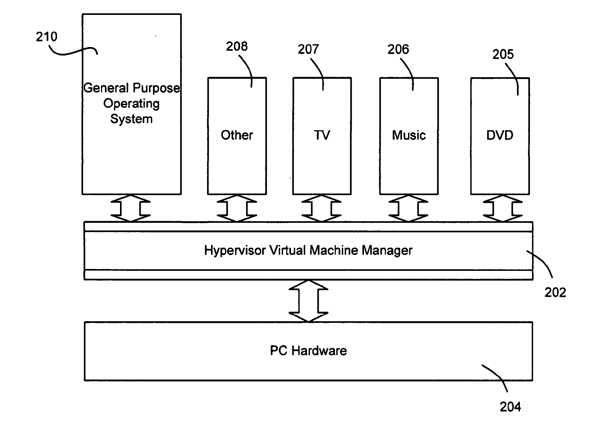
A couple of years ago, various laptop manufacturers began implementing “instant-on” solutions to their mobile PCs with lite variations of Linux for a fast boot experience. Although it didn’t catch on very well, Microsoft took the idea to the next level with a hypervisor-enabled fast-boot dual-boot solution that makes much more sense.
The patent application, “FAST BOOTING A COMPUTING DEVICE TO A SPECIALIZED EXPERIENCE” outlines a boot process involving a general operating system like Windows alongside many special purpose operating systems that boots much more quickly to provide “appliance-like behavior” such as viewing entertainment content (TV, music, DVD).
Up until now it might just sound like a traditional dual-boot scenario, but since operating systems are running on top of a hypervisor, Microsoft proposes that after the user is launched into the specialized OS, the general purpose OS would actually start loading in the background too. Furthermore, once the two are running side by side, the system may automatically and seamlessly transition the user to the general OS.
The end result is instant gratification from a fast-boot experience, at the same time, the flexibility to do more without compromise. Win win.
Personally I think this could be a great practical application of hypervisor technology, especially Microsoft’s Hyper-V, in the consumer operating system space. Since boot time is a huge advantage of embedded devices over a PC, together with all the investments Microsoft has made in componentizing Windows like Media Center, it’s highly likely we’ll see this implemented sooner than later.
Update: Manan Kakkar has more evidence to suggest that this feature may even be a part of Windows 8 as “Direct experience”.
I only hope MS can only get this technology out the door before 2015. MS is never short on innovation, only on implementation, it seems.
i remember hp had this using xp embeded but unfortunatly counldnt trasition the windows software it was based on to vista so they replaced it entually with some app from cyberlink & disabled the xp embedded idea. i think dell had a similar thing aswell. sounds like a great idea though compared to Phoenix’s failed concept
looking it up now it was called HyperSpace
That’s desirable generally, but critical to any tablet effort using W8. If it’s not in there by then, they’re dead in tablets. Then again, if they wait two more years to respond to iPad, Android, XOOM, HP, they’re probably dead there already.
I sure hope “Other” is WP7 or some version thereof. If MS was smart they’d release a tablet friendly version of WP7 this year. Then when Windows 8 is ready they can provide device manufacturers with the “business edition” of a tablet OS with Windows 8 and WP7 riding shotgun as “Other”. The best of both worlds.
Yes I agree with above, MS should release WP7 re-branded as a tablet OS. Then when Windows 8 comes around they could have the instant-on feature with the GUI similar to WP7 or the next-gen WP8. This could then load Windows 8 in the background on tablet and PC devices. The Windows eco-system would then fit nicely together over the multiple form factors including touch devices.
Make Windows Media Center one of those specialised OSes and tailor WP7 for tablet mode, include them both as bootables in Windows 8, and Microsoft has a winner. It’d function as a set-top box, as a tablet, and as a general purpose OS. Sounds like magic.
it would be nice if they made it like they did with xp mce where you could have it where it doesnt require a personal user account to use @ startup
If you want a W7 box to boot into Media Center without waiting for a login, that’s easy enough to do by enabling auto-login. That’s how my MC-box is configured, boots, auto-login, MC started from the startup up folder, works a treat.